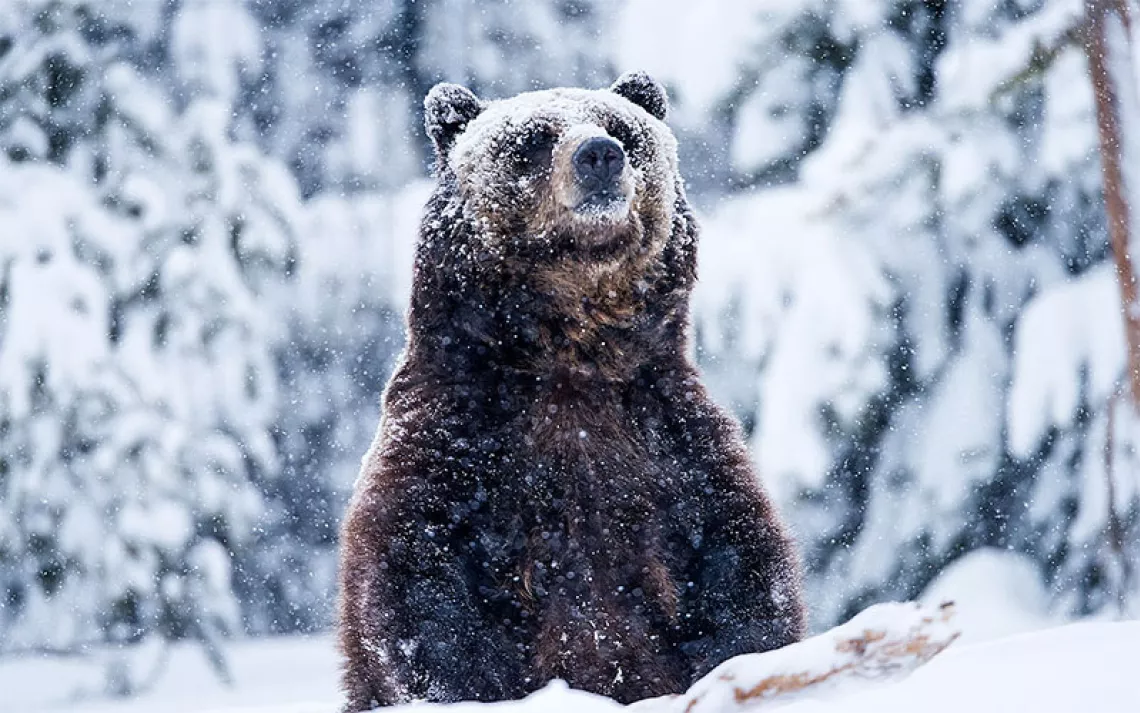This Invasive Fish Got an Anti-Racist Rebrand
What’s in a name? A lot.

Photo by Alex Garcia
Kevin Irons spent years on a top-secret project at the Illinois Department of Natural Resources (IDNR), where he’s the assistant fisheries chief. But on June 22, he was finally ready for the big reveal—the state’s invasive Asian carp was debuting a brand-new name.
It’s “copi,” short for “copious,” which the fish certainly are in Illinois’s waterways. Copi are actually four very different fish species native to China: grass, bighead, black, and silver carp. Since their introduction half a century ago, they’ve come to dominate midwestern lakes and rivers, outcompeting other fish. Their eradication has been the target of hundreds of millions of federal and state dollars.
The new moniker’s main goal is to encourage people to eat the fish, whose decades-old status as a nuisance species has proved to be a roadblock for prospective diners. But some also saw xenophobic undertones in the old name, and the change comes amid a wider shift to banish offensive terms for everything from insects and birds to mountains. Such changes, in turn, raise big questions about the power of language to shape the way we see the natural world.
*
The old name hadn’t been around for long. The US Fish and Wildlife Service first used the group term “Asian carp” for the four invasive fish during a workshop in 2000. Seven years later, the agency formalized the first Asian carp management plan, and in 2010 Irons joined IDNR’s massive new Asian Carp Regional Coordinating Committee.
Two decades earlier, he’d seen one of the first bighead carp captured in Illinois; a confused local fisherman had brought the strange fish, dripping blood onto the carpet, into Irons’s office. Now the four species make up 70 percent of all biomass in some of the state’s rivers.
The carp had arrived in the United States under the guidance of the Environmental Protection Agency, which was searching for ways to manage algae blooms with fish, rather than chemicals. Catfish aquaculture managers imported silver and bighead carp to clean their ponds in the early 1970s. The filter-feeding fish, which could eat their weight in plankton in a day, seemed like the perfect solution.
There was also the added benefit of a limited built-in market. In China, silver, bighead, black, and grass carp, are called sì dà jiā yú, or “the four famous domestic fishes,” and have been cultivated together as food for more than 800 years—the oldest documented polyculture crop in the world. Once they were fattened from pond cleaning, the fish could then be sold as food in limited markets; US aquaculture managers shipped the carp to cities with large Chinese-heritage populations.
But soon, the fish escaped into the wild. They began to overwhelm waterways. Facing a population boom, the IDNR committee did what it had to, Irons said, to get the money it needed from Congress. That included hyping up the fish as frightening invaders from abroad.
“It was a marketing campaign,” he said. “I'm a scientist, and I'd rather talk about the science and the probability of this, but we didn't have time.” News outlets picked up on the story’s narrative drama. Irons remembers media coverage of bloodied silver carp jumping into boats and injuring people. “There were fear campaigns put out about this,” he said. “Silver carp are bad; they’re invasive.”
*
That message has become counterproductive. “Consuming them could be a great part of management,” Irons said. “So now we’ve got to tell people the fish we’re having a fearmonger campaign about is actually pretty delicious.” The problem was the image of invasive carp the IDNR had spent years painting—an Asian invader that didn’t play by the rules.
In recent years, such framing has received criticism as xenophobic too. In 2014, Minnesota banned the term “Asian carp” in a statute on the grounds of cultural insensitivity. “Invasive carp” became the state’s new legal term.
And last year, in the wake of anti-Asian violence across the country and facing public pressure, the US Geological Survey and FWS announced they would follow Minnesota’s lead and begin referring to silver, grass, black, and bighead carp collectively only as “invasive carp.”
“This term is more in sync with our values as a science-based agency committed to serving a diverse American public,” Charlie Wooley, FWS's Midwest regional director, said in a statement. And the carp aren’t the only species with new names. Also citing the rise in anti-Asian discrimination, the Entomological Society of America announced in July that the so-called “murder hornet,” or “Asian giant hornet,” would now be called the “northern giant hornet.” It’s part of the society’s Better Common Names Project, an effort to remove ethnic slurs and other derogatory terms from the field. The grassroots Bird Names for Birds campaign is pressuring the American Ornithological Society to find descriptive names for birds like Bachman’s sparrow, which honors a revered ornithologist and avowed white supremacist. In recent years, even mountains—such as South Dakota’s Black Elk Peak, formerly named for a US Army general involved in a massacre of Sioux women and children—have been renamed.
Retired North Carolina fisheries biologist Bryn Tracy thinks it’s time his field joined the movement. He’s calling on the American Fisheries Society (AFS) to create a framework for renaming fish, including at least 30 in North Carolina named for racist white men, like the freshwater goby, whose scientific name, Ctenogobius shufeldti, honors white supremacist and eugenicist Robert Shufeldt. Tracy hopes to use local Cherokee or Croatoan names, which predate white settlement, for the fish instead. The proposal is laid out in a forthcoming essay in the society’s journal.
“I'm expecting blowback,” Tracy said. “Simply because ichthyologists, like ornithologists—some of them are very entrenched and resistant to change. I’m certainly expecting some letters to the editor.” There is precedent for positive change. In the early 1990s the organization conceded to public pressure and changed a few particularly egregious common names, like the “squawfish” (now the pikeminnow) and the “jewfish” (renamed the goliath grouper).
“Scientists are coming to this conclusion that we should be naming things either after where they’re found, using the Indigenous peoples’ names, or something descriptive of that particular organism,” Tracy said.
*
The word “invasive” has faced scrutiny too. In the past decade, some invasion biologists, who study the spread of introduced species in new environments, have argued their field’s central metaphor of nonnative trespassers threatening native species is xenophobic. An influential 2011 paper by 19 ecologists in the journal Nature made a case for highlighting species’ impact, not origins. Native species aren’t inherently good, they wrote, and introduced ones aren’t necessarily harmful.
Friends of the Mississippi River (FMR) is a nonprofit group in Minnesota focused on ecosystem restoration and conservation, and it's been thinking a lot about the power of language. “Historically, people intentionally capitalized on anti-group sentiment to drum up support for campaigns to remove invasive species,” said Alex Roth, the organization’s land conservation director. A good example is Japanese barberry, he said. During World War I, the US government called it “kin of the kaiser” and the “red-handed anarchist of the grain fields,” drawing on nationalistic sentiment to eradicate the “alien enemy” host of black stem rust, which threatened wheat crops amid the war effort.
Roth doesn’t think the “Asian carp” naming was as intentionally xenophobic, but it had a similar effect. “The early stages of invasion are where you have the best chance of getting rid of a species before it establishes, spreads, and begins to cause harm,” he said. “And they were at that stage where they had to respond quickly. And so their chosen methodology was to make this into a national security campaign. . . . I think they did that without fully understanding their actions or the impacts of their words.”
Colleen O’Connor Toberman manages the invasive carp program at FMR. When it comes to carp, she thinks identifying the species as invasive or alien isn’t very useful. “Where these fish came from, where their native habitats are, honestly isn’t very important,” she said. “What’s important is the impact they have on our ecosystems.”
The harder question is what to call invasive species instead of just that. FMR relies on the term “introduced,” but Roth said they’re also learning from Indigenous partner organizations like the Lower Phalen Creek Project.
“A lot of our Native partners use the term ‘displaced plant relatives’ to talk about species that are not from here but were brought here through colonization and now may or may not have unintended negative effects,” Roth said. “It's a lot more about kinship and respect. And one of the things that we've taken from that is that none of these species are good or bad.”
The term “invasive” is also rooted in colonialism and militaristic violence. “It is difficult, but certainly not impossible, I think, to use language that is nonviolent but still underscores that we need to act—we need to act together,” said Toberman.
By seeking to make the fish more marketable, “copi” sheds both the xenophobic connotations of “Asian carp” and the militaristic “invasive” label. For now, managers hope the newly renamed fish is one we can learn to live with (and maybe love to eat) in a changing world.
A carp by any other name may be too hard to swallow.
 The Magazine of The Sierra Club
The Magazine of The Sierra Club



